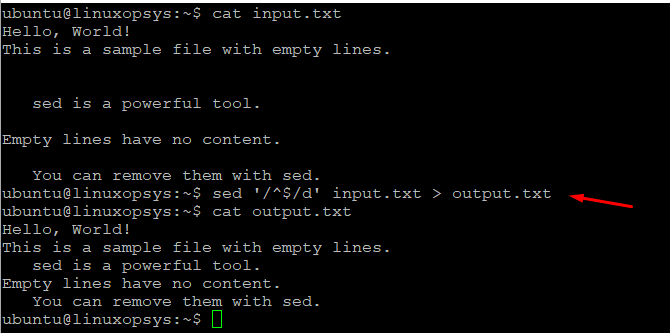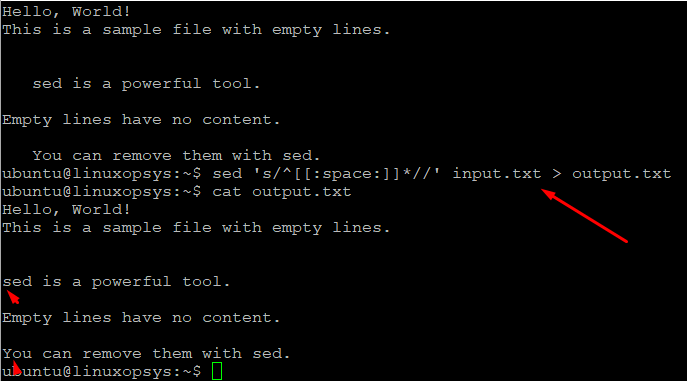sed, short for "stream editor," is a command-line utility in Linux and Unix-like operating systems used primarily for text manipulation and processing. Its primary usage is to process and transform text using a set of specified commands, often based on regular expressions.
Primary Usage:
- Commonly used for search-and-replace operations, text filtering, and text transformations in pipelines and scripts.
- It allows you to specify patterns using regular expressions to perform various text manipulation tasks, such as substitution, deletion, insertion, and more.
Syntax
The basic syntax of the sed command is as follows:
sed OPTIONS 'COMMAND' INPUT_FILEHere are some common options you can use with sed:
-n: Suppress automatic printing of pattern space.-i: Edit files in place (make sure to back up files before using this option).-r: Use extended regular expressions (regex).-e: Specify multiple sed commands.
Let's use the following sample text file as INPUT_FILE:
cat sample.txtHello, World!
This is a sample file for sed examples.
Replace the World with Folks! Thanks World!
sed is a powerful tool.Common sed Commands
Let's look into the sed command with examples.
Printing Lines
Example 1: Print the entire file
sed -n 'p' sample.txtOutput:
Hello, World!
This is a sample file for sed examples.
Replace the World with Folks! Thanks World!
sed is a powerful tool.Example 2: Print specific line
sed -n '3p' sample.txtPrints the third line.
Output:
Replace the World with Folks! Thanks World!Example 3: Print a range of lines
sed -n '2,3p' sample.txtPrints lines 2 and 3.
Output:
This is a sample file for sed examples.
Replace the World with Folks! Thanks World!Example 4: Print every other line
sed -n '1~2p' sample.txtPrints every other line starting from the first line.
Output:
Hello, World!
Replace the World with Folks! Thanks World!Replacing String
Example 5: Replace a string
sed 's/World/Folks!/' sample.txtOutput:
Hello, Folks!!
This is a sample file for sed examples.
Replace the Folks! with Folks! Thanks World!
sed is a powerful tool.This replaces the first occurrence of 'World' with 'Folks!' on each line. On the third line, you can see only one occurrence is replaced.
Example 6: Replace all occurrences of a string
sed 's/World/Folks!/g' sample.txtOutput:
Hello, Folks!!
This is a sample file for sed examples.
Replace the Folks! with Folks! Thanks Folks!!
sed is a powerful tool.This replaces all occurrences of 'World' with 'Folks!' on each line using the g (global) option. You can see the difference in the third line.
To perform a case-insensitive global substitution use s/World/Folks!/gI, where I flag that makes the substitution case insensitive.
Example 7: Replace Nth occurrence of a string
sed 's/World/Folks!/2g' sample.txtOutput:
Hello, World!
This is a sample file for sed examples.
Replace the World with Folks! Thanks Folks!!
sed is a powerful tool.Replace the second occurrence and beyond of 'World' with 'Folks!' on each line using the 2g option. The output would be the same as above.
Example 8: Replace string on a specific line number
sed '3s/World/Folks!/' sample.txtHello, World!
This is a sample file for sed examples.
Replace the Folks! with Folks! Thanks World!
sed is a powerful tool.This replaces 'World' with 'Folks!' on the third line for the first occurrence.
Example 9: Replace string on a range of lines
sed '2,3s/World/Folks!/' sample.txtThe above command replaces 'World' with 'Folks!' on lines 2 and 3.
Example 10: Replace multiple strings
sed 's/World/Folks!/g; s/Hello/Hi/g' sample.txtOutput:
Hi, Folks!!
This is a sample file for sed examples.
Replace the Folks! with Folks! Thanks Folks!!
sed is a powerful tool.Replaces 'World' with 'Folks!' and 'Hello' with 'Hi' on each line.
You could also make use of extended regex and the command should look sed 's/\(Hello\|World\)/Hi/g' sample.txt.
Deleting Lines
Example 11: Delete specific lines
sed '3d' sample.txtHello, World!
This is a sample file for sed examples.
sed is a powerful tool.The third line from the file gets deleted.
Example 12: Delete the last line
sed '$d' sample.txtHere $ sign to denote the last line.
Some more useful examples of deleting lines:
Delete lines from a range: sed '2,3d' sample.txt
Delete lines from a given line number to the last line: sed '2,$d' sample.txt
Delete pattern-matching lines: sed '/World/d' sample.txt
Delete odd lines: sed '1~2d' sample.txt
Remove Character
Example 13: Remove all empty lines
sed '/^$/d' input.txt > output.txtThis removes all empty lines (lines with no content) from a file. In the command /^$/ is a regular expression pattern that matches empty lines. It looks for lines that start ^ and immediately end $ with no characters in between.
Sometimes you need to use /^\s*$/ to match lines that are either truly empty (contain no visible characters) or lines that contain only whitespace characters (spaces, tabs, etc.).

Example 14: Remove all bank spaces at at beginning of each line
sed 's/^[[:space:]]*//' input.txt > output.txtThis removes all leading blank spaces (whitespace characters at the beginning of each line) from a file.

Example 15: Remove all bank spaces at at end of each line
sed 's/[[:space:]]*$//' input.txt > output.txtor
sed 's/[[:blank:]]*$//' input.txt > output.txtBoth command removes all trailing blank spaces from a file.
The difference is that the character class [:space:] includes all whitespace characters, including newlines and carriage returns, while [:blank:] specifically represents horizontal whitespace, which includes space and tab characters.
Example 16: Remove all special characters removed from each line
sed 's/[^a-zA-Z0-9 ]//g' input.txt > output.txtIf you want to remove a specific set of special characters, for example, if you want to remove characters such as !, @, #, $, %, etc., you can modify the command like this:
sed -i 's/[!@#$%]//g' file.txtYour intention is only to remove non-printable characters from a file, then try this:
sed -i 's/[^[:print:]]//g' file.txtNote: Here i option modifies the original file (file.txt) rather than printing the result to the standard output.
Inserting and Appending Text
Example 17: Insert text before a specific line number
sed '3i This is a new line' input.txt > output.txtThis inserts the text "This is a new line" before line 3 of the input file.

Example 18: Append text after a specific line number
sed '2a This line was appended' input.txt > output.txtMultiple substitutions
You can perform multiple substitutions in a single sed command by chaining them together using semicolons ;.
Example 19: Using Semicolon Separator (;)
sed 's/old_text_1/new_text_1/g; s/old_text_2/new_text_2/g' input.txt > output.txtYou can also use multiple -e flags followed by substitution commands to perform multiple sequential operations.
Example 20: Using -e Flag
sed -e 's/old_text_1/new_text_1/g' -e 's/old_text_2/new_text_2/g' input.txt > output.txt



Comments